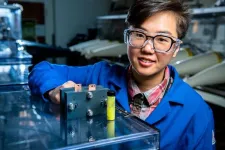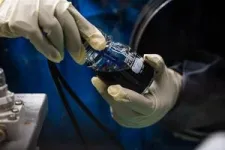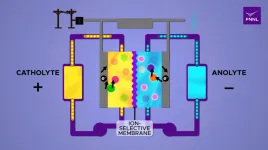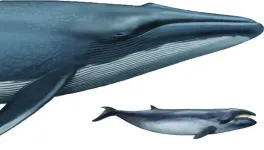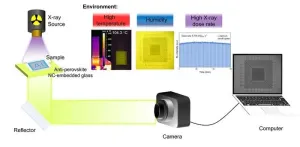(Press-News.org) RICHLAND, Wash.—A common food and medicine additive has shown it can boost the capacity and longevity of a next-generation flow battery design in a record-setting experiment.
A research team from the Department of Energy’s Pacific Northwest National Laboratory reports that the flow battery, a design optimized for electrical grid energy storage, maintained its capacity to store and release energy for more than a year of continuous charge and discharge.
The study, just published in the journal Joule, details the first use of a dissolved simple sugar called β-cyclodextrin, a derivative of starch, to boost battery longevity and capacity. In a series of experiments, the scientists optimized the ratio of chemicals in the system until it achieved 60 percent more peak power. Then they cycled the battery over and over for more than a year, only stopping the experiment when the plastic tubing failed. During all that time, the flow battery barely lost any of its activity to recharge. This is the first laboratory-scale flow battery experiment to report more than a year of continuous use with minimal loss of capacity.
The β-cyclodextrin additive is also the first to speed the electrochemical reaction that stores and then releases the flow battery energy, in a process called homogeneous catalysis. This means the sugar does its work while dissolved in solution, rather than as a solid applied to a surface.
“This is a brand new approach to developing flow battery electrolyte,” said Wei Wang, a long-time PNNL battery researcher and the principal investigator of the study. “We showed that you can use a totally different type of catalyst designed to accelerate the energy conversion. And further, because it is dissolved in the liquid electrolyte it eliminates the possibility of a solid dislodging and fouling the system.”
What is a flow battery?
As their name suggests, flow batteries consist of two chambers, each filled with a different liquid. The batteries charge through an electrochemical reaction and store energy in chemical bonds. When connected to an external circuit, they release that energy, which can power electrical devices. Flow batteries differ from solid-state batteries in that they have two external supply tanks of liquid constantly circulating through them to supply the electrolyte, which is like the “blood supply” for the system. The larger the electrolyte supply tank, the more energy the flow battery can store.
If they are scaled up to the size of a football field or more, flow batteries can serve as backup generators for the electric grid. Flow batteries are one of the key pillars of a decarbonization strategy to store energy from renewable energy resources. Their advantage is that they can be built at any scale, from the lab-bench scale, as in the PNNL study, to the size of a city block.
Why do we need new kinds of flow batteries?
Large-scale energy storage provides a kind of insurance policy against disruption to our electrical grid. When severe weather or high demand hobble the ability to supply electricity to homes and businesses, energy stored in large-scale flow battery facilities can help minimize disruption or restore service. The need for these flow battery facilities is only expected to grow, as electricity generation increasingly comes from renewable energy sources, such as wind, solar and hydroelectric power. Intermittent power sources such as these require a place to store energy until it’s needed to meet consumer demand.
While there are many flow battery designs and some commercial installations, existing commercial facilities rely on mined minerals such as vanadium that are costly and difficult to obtain. That’s why research teams are seeking effective alternative technologies that use more common materials that are easily synthesized, stable and non-toxic.
“We cannot always dig the Earth for new materials,” said Imre Gyuk, director of energy storage research at DOE’s Office of Electricity. “We need to develop a sustainable approach with chemicals that we can synthesize in large amounts—just like the pharmaceutical and the food industries.”
The work on flow batteries is part of a large program at PNNL to develop and test new technologies for grid-scale energy storage that will be accelerated with the opening of PNNL’s Grid Storage Launchpad in 2024.
A benign ‘sugar water’ sweetens the pot for an effective flow battery
The PNNL research team that developed this new battery design includes researchers with backgrounds in organic and chemical synthesis. These skills came in handy when the team chose to work with materials that had not been used for battery research, but which are already produced for other industrial uses.
“We were looking for a simple way to dissolve more fluorenol in our water-based electrolyte,” said Ruozhu Feng, the first author of the new study. “The β-cyclodextrin helped do that, modestly, but it’s real benefit was this surprising catalytic ability.”
The researchers then worked with co-author Sharon Hammes-Schiffer of Yale University, a leading authority on the chemical reaction underlying the catalytic boost, to explain how it works.
As described in the research study, the sugar additive accepts positively charged protons, which helps balance out the movement of negative electrons as the battery discharges. The details are a bit more complicated, but it’s like the sugar sweetens the pot to allow the other chemicals to complete their chemical dance.
The study is the next generation of a PNNL-patented flow battery design first described in the journal Science in 2021. There, the researchers showed that another common chemical, called fluorenone, is an effective flow battery component. But that initial breakthrough needed improvement because the process was slow compared with commercialized flow battery technology. This new advance makes the battery design a candidate for scale up, the researchers say.
At the same time, the research team is working to further improve the system by experimenting with other compounds that are similar to β-cyclodextrin but smaller. Like honey, β-cyclodextrin addition also makes the liquid thicker, which is less than ideal for a flowing system. Nonetheless, the researchers found its benefits outweighed its drawbacks.
Understanding the complex chemistry happening inside the new flow battery design required the expertise of many scientists, including Ying Chen, Xin Zhang, Peiyuan Gao, Ping Chen, Sebastian Mergelsberg, Lirong Zhong, Aaron Hollas, Yangang Lian, Vijayakumar Murugesan, Qian Huang, Eric Walter and Yuyan Shao of PNNL, and Benjamin J. G. Rousseau and Hammes-Schiffer of Yale, in addition to Feng and Wang.
The research team has applied for U.S. patent protection for their new battery design.
Click here to learn more about licensing the new technology.
This study received support from the DOE Office of Electricity through its Energy Storage Program and from internal research investments through the Energy Storage Materials Initiative at PNNL. The Center for Molecular Electrocatalysis, an Energy Frontier Research Center funded by the DOE Office of Science, Basic Energy Sciences, supported mathematical calculations that explained the boost in battery capacity. Additional supporting calculations and imaging studies were performed at the Environmental Molecular Sciences Laboratory, a national scientific user facility located at PNNL.
# # #
About PNNL
Pacific Northwest National Laboratory draws on its distinguishing strengths in chemistry, Earth sciences, biology and data science to advance scientific knowledge and address challenges in sustainable energy and national security. Founded in 1965, PNNL is operated by Battelle for the Department of Energy’s Office of Science, which is the single largest supporter of basic research in the physical sciences in the United States. DOE’s Office of Science is working to address some of the most pressing challenges of our time. For more information, visit https://energy.gov/science. For more information on PNNL, visit PNNL's News Center. Follow us on Twitter, Facebook, LinkedIn and Instagram.
END
Next-generation flow battery design sets records
Sugar additive plays a surprise role, boosting flow battery capacity and longevity for this grid energy resilience design
2023-07-10
ELSE PRESS RELEASES FROM THIS DATE:
Making headway in precision therapeutics with novel fully organic bioelectronic device
2023-07-10
New York, NY—July 10, 2023—As researchers make major advances in medical care, they are also discovering that the efficacy of these treatments can be enhanced by individualized approaches. Therefore, clinicians increasingly need methods that can both continuously monitor physiological signals and then personalize responsive delivery of therapeutics.
Need for safe, flexible bioelectronic devices
Implanted bioelectronic devices are playing a critical role in these treatments, but there are a number of challenges that have stalled their widespread adoption. These devices require specialized components for signal acquisition, processing, data transmission, and powering. ...
The American Journal of Health Economics presents a special cluster on the opioid crisis
2023-07-10
The August 2023 issue of the American Journal of Health Economics will feature a cluster of articles that examine the opioid crisis. These articles consider such topics as access to treatment for opioid use, the impact of the Affordable Care Act on opioid-related emergency department visits, and the effectiveness of prescription drug monitoring programs.
In “Do Policies to Increase Access to Treatment for Opioid Use Disorder Work?” authors Leemore S. Dafny, Eric Barrette, and Karen Shen use longitudinal patient-level claims data to examine the impact of demand and supply-side policies on treatment rates among patients diagnosed with opioid ...
NJIT awarded $10 million for technical assistance at polluted brownfield sites through EPA grant
2023-07-10
New Jersey Institute of Technology has been awarded $10 million by the U.S. Environmental Protection Agency (EPA) as part of a $315 million initiative from President Biden’s Investing in America Agenda to expedite the assessment and cleanup of brownfield sites across the country. The funding comes entirely from the historic $1.5 billion investment from Biden’s Bipartisan Infrastructure Law.
Brownfields are abandoned or underutilized properties that may have hazardous substances, pollutants, or contaminants present, making their redevelopment complex.
Under the EPA’s Technical Assistance to ...
Whale of a debate put to rest
2023-07-10
Researchers have finally settled a decades-long dispute about the evolutionary origins of the pygmy right whale.
The smallest of the living baleen whales, it’s tank-like skeleton is unique, and its ecology and behaviour remain virtually unknown.
Because it is so unusual, the evolutionary relationships of the pygmy right whale (Caperea marginata) have long been a bone of contention.
In a study that solves the debate, just published in Marine Mammal Science, an international group of researchers sequenced the complete genome of Caperea, combining ...
Acute kidney injury not associated with worsening kidney function in persons with CKD
2023-07-10
1. Acute kidney injury not associated with worsening kidney function in persons with CKD
Findings suggest kidney disease observed after AKI often present before injury
Abstract: https://www.acpjournals.org/doi/10.7326/M22-3617
URL goes live when the embargo lifts
A study of hospitalized persons with chronic kidney disease (CKD) fournd that acute kidney injury (AKI) did not predict worsening of kidney function trajectory once difference in pre-hospitalization characteristically were fully accounted for. Instead, the authors suggest that much of determinants of faster ...
New fish species discovered after decades of popularity in the aquarium trade
2023-07-10
With just a few clicks of a mouse, you can purchase your very own redtail garra, a type of fish that feeds on algae. Information about the fish’s biology, however, is much less easily obtained. That’s because redtail garra, although popular in the aquarium trade since the early 2000s, has until now been unknown to science.
Researchers were peripherally aware of the fish’s existence, but “discovering” a new species requires scientific description based on specimens collected in their natural ...
Hospital understaffing and poor work conditions associated with physician and nurse burnout and intent to leave
2023-07-10
PHILADELPHIA (July 10, 2023) – A unique collaborative study on hospital clinician wellbeing by teams at 60 of the nation’s best hospitals, defined by Magnet Hospital Recognition, was published today in JAMA Health Forum. The study found that physicians and nurses, even at hospitals known to be good places to work, experienced adverse outcomes during the pandemic and want hospital management to make significant improvements in their work environments and in patient safety. The solutions to high hospital clinician burnout and turnover, they say, are not resilience training ...
Anti-inflammatory drugs did not speed COVID-19 recovery but prevented deaths
2023-07-10
Two drugs commonly used to treat inflammatory diseases such as rheumatoid arthritis and psoriasis did not shorten recovery time for patients hospitalized with severe COVID-19 but did reduce the likelihood of death when compared with standard care alone, according to a national study led by Washington University School of Medicine in St. Louis. The study was funded by the Biomedical Advanced Research and Development Authority (BARDA) of the Administration for Strategic Preparedness and Response within the U.S. Department of Health and Human Services (HHS). The study was coordinated by the National Center for Advancing Translational Sciences (NCATS) of the National Institutes of Health ...
Illuminating the future of X-ray imaging: High-resolution and ultrastable solutions with lead-free anti-perovskite nanocrystals
2023-07-10
In the realms of material inspection, medical diagnostics, astronomical discovery, and scientific research, the demand for high-resolution and ultrastable X-ray imaging methods has ignited a fervent pursuit of innovative X-ray-responsive materials. These sought-after materials must possess exceptional qualities such as high X-ray attenuation, efficient scintillation, rapid light decay, and robust durability. Among them, lead-halide-based perovskites have emerged as a compelling contender due to their remarkable luminescence efficiency, superior X-ray attenuation capabilities, and short ...
DOE announces $72 million for small business research and development grants
2023-07-10
WASHINGTON, D.C. — The U.S. Department of Energy (DOE) today announced $72 million in funding for small businesses to pursue scientific, clean energy, and climate research, development, and demonstration projects. The funding will support 296 projects across 44 states and addresses multiple topic areas, such as renewable energy, nuclear energy, cybersecurity, advanced materials and manufacturing, microelectronics, and artificial intelligence. Today’s announcement underscores the Biden-Harris Administration's deep commitment to advancing innovative climate solutions and strengthening America’s ...
LAST 30 PRESS RELEASES:
Numbers in our sights affect how we perceive space
SIMJ announces global collaborative book project in commemoration of its 75th anniversary
Air pollution exposure and birth weight
Obstructive sleep apnea risk and mental health conditions among older adults
How talking slows eye movements behind the wheel
The Ceramic Society of Japan’s Oxoate Ceramics Research Association launches new international book project
Heart-brain connection: international study reveals the role of the vagus nerve in keeping the heart young
Researchers identify Rb1 as a predictive biomarker for a new therapeutic strategy in some breast cancers
Survey reveals ethical gaps slowing AI adoption in pediatric surgery
Stimulant ADHD medications work differently than thought
AI overestimates how smart people are, according to HSE economists
HSE researchers create genome-wide map of quadruplexes
Scientists boost cell "powerhouses" to burn more calories
Automatic label checking: The missing step in making reliable medical AI
Low daily alcohol intake linked to 50% heightened mouth cancer risk in India
American Meteorological Society announces Rick Spinrad as 2026 President-Elect
Biomass-based carbon capture spotlighted in newly released global climate webinar recording
Illuminating invisible nano pollutants: advanced bioimaging tracks the full journey of emerging nanoscale contaminants in living systems
How does age affect recovery from spinal cord injury?
Novel AI tool offers prognosis for patients with head and neck cancer
Fathers’ microplastic exposure tied to their children’s metabolic problems
Research validates laboratory model for studying high-grade serous ovarian cancer
SIR 2026 delivers transformative breakthroughs in minimally invasive medicine to improve patient care
Stem Cell Reports most downloaded papers of 2025 highlight the breadth and impact of stem cell research
Oxford-led study estimates NHS spends around 3% of its primary and secondary care budget on the health impacts of heat and cold in England
A researcher’s long quest leads to a smart composite breakthrough
Urban wild bees act as “microbial sensors” of city health.
New study finds where you live affects recovery after a hip fracture
Forecasting the impact of fully automated vehicle adoption on US road traffic injuries
Alcohol-related hospitalizations from 2016 to 2022
[Press-News.org] Next-generation flow battery design sets recordsSugar additive plays a surprise role, boosting flow battery capacity and longevity for this grid energy resilience design
